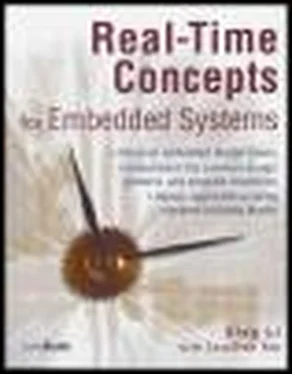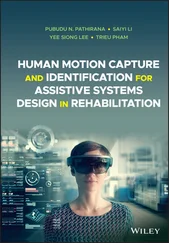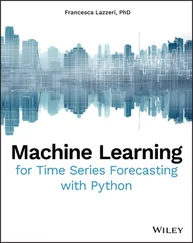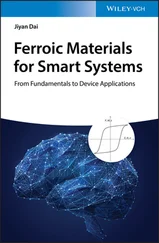· initializing the memory system for downloading the image, and
· initializing the interrupt controller and installing default interrupt handlers.
The monitor has a well-defined user interface accessible through a terminal emulation program over the serial interface. The monitor defines a set of commands allowing the developer to
· download the image,
· read from and write to system memory locations,
· read and write system registers,
· set and clear different types of breakpoints,
· single-step instructions, and
· reset the system.
The way in which the monitor downloads the image from the host system over the serial or network connection is similar to how the loader does it. The monitor is capable of downloading the image into either the RAM memory or the flash memory. In essence, the monitor has both the boot image and the loader functionalities incorporated but with the added interactive debug capability. The monitor is still present while the newly downloaded image executes. A special keystroke on the host system, for example, CTRL+D, interrupts the program execution and reactivates the monitor user interface so the developer can conduct interactive debugging activities.
The monitor is generally developed by the hardware engineers and is also used by the hardware engineers to perform both system device diagnostics and low-level code debugging. Some manufactures give the monitor source code to their customers. In that case, the code can be extracted and modified to work with a custom-designed target board.
The target debug agent functions much like the monitor does but with one added feature: the target agent gives the host debugger enough information to provide visual source-level debug capability. Again, an agreed-upon communication protocol must be established between the host debugger and the target agent. The host debugger is something that the host tools vendor offers. Sometimes a RTOS vendor offers a host-based debugger simply because the debug agent is an integral part of the RTOS. The host debugger vendor works closely with the RTOS vendor to provide a fully compatible tool. The debug agent has built-in knowledge of the RTOS objects and services, which allows the developer to explore such objects and services fully and visually.
3.3 Target Boot Scenarios
We have described the software components involved in transferring images from the host to the target. In this section, we describe the details of the loading process itself and how control is transferred to the newly acquired image.
Embedded processors, after they are powered on, fetch and execute code from a predefined and hard-wired address offset. The code contained at this memory location is called the reset vector . The reset vector is usually a jump instruction into another part of the memory space where the real initialization code is found. The reason for jumping to another part of memory is to keep the reset vector small. The reset vector belongs to a small range of memory space reserved by the system for special purposes. The reset vector, as well as the system boot startup code, must be in permanent storage. Because of this issue, the system startup code, called the bootstrap code, resides in the system ROM, the on-board flash memory, or other types of non-volatile memory devices. We will revisit the loader program from the system-bootstrapping perspective. In the discussions to follow, the loader refers to the code that performs system bootstrapping, image downloading, and initialization.
The concepts are best explained through an example. In this example, assume an embedded loader has been developed and programmed into the on-board flash memory. Also, assume that the target image contains various program sections. Each section has a designated location in the memory map. The reset vector is contained in a small ROM, which is mapped to location 0x0h of the address space. The ROM contains some essential initial values required by the processor on reset. These values are the reset vector, the initial stack pointer, and the usable RAM address.
In the example shown in Figure 3.2, the reset vector is a jump instruction to memory location 0x00040h; the reset vector transfers program control to the instruction at this address. Startup initialization code begins at this flash memory address. This system initialization code contains, among other things, the target image loader program and the default system exception vectors. The system exception vectors point to instructions that reside in the flash memory. See Chapter 10 for detailed discussions on interrupts, exceptions, and exception vectors and handlers.
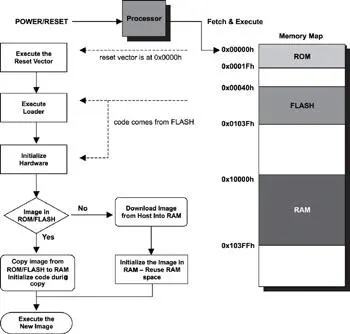
Figure 3.2: Example bootstrap overview.
The first part of the system bootstrap process is putting the system into a known state. The processor registers are set with appropriate default values. The stack pointer is set with the value found in the ROM. The loader disables the system interrupts because the system is not yet prepared to handle the interrupts. The loader also initializes the RAM memory and possibly the on-processor caches. At this point, the loader performs limited hardware diagnostics on those devices needed for its operation.
As discussed in Chapter 2, program execution is faster in RAM than if the executable code runs directly out of the flash memory. To this end, the loader optionally can copy the code from the flash memory into the RAM. Because of this capability, a program section can have both a load address and a run address. The load address is the address in which the program sections reside, while the run address is the address to which the loader program copies the program sections and prepares it for execution. Enabling runtime debugging is another main reason for a program to execute out of the RAM. For example, the debugger must be able to modify the runtime code in order to insert breakpoints.
An executable image contains initialized and uninitialized data sections. These sections are both readable and writeable. These sections must reside in RAM and therefore are copied out of the flash memory into RAM as part of system initialization. The initialized data sections (.data and.sdata) contain the initial values for the global and static variables. The content of these sections, therefore, is part of the final executable image and is transferred verbatim by the loader. On the other hand, the content for the uninitialized data sections.bss and.sbss) is empty. The linker reserves space for these sections in the memory map. The allocation information for these sections, such as the section size and the section run address, is part of the section header. It is the loader’s job to retrieve this information from the section header and allocate the same amount of memory in RAM during the loading process. The loader places these sections into RAM according to the section’s run address.
An executable image is likely to have constants. Constant data is part of the.const section, which is read-only. Therefore, it is possible to keep the.const section in read-only memory during program execution. Frequently accessed constants, such as lookup tables, should be transferred into RAM for performance gain.
The next step in the boot process is for the loader program to initialize the system devices. Only the necessary devices that the loader requires are initialized at this stage. In other words, a needed device is initialized to the extent that a required subset of the device capabilities and features are enabled and operational. In the majority of cases, these devices are part of the I/O system; therefore, these devices are fully initialized when the downloaded image performs I/O system initialization as part of the startup sequence.
Читать дальше
